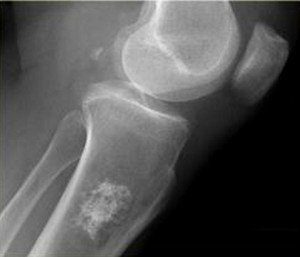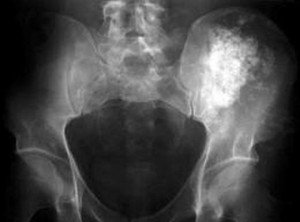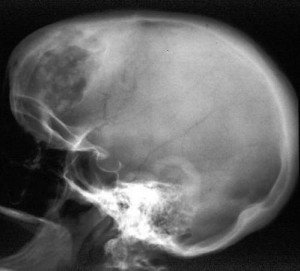What is Chondrosarcoma?
Chondrosarcoma is a malignant tumor of the category known as sarcomas. It is composed of transformed cells that produce cartilage. Cartilage is flexible connective tissue found in many areas in the bodies of humans and other animals. Chondrosarcoma is more common in men than in women and among older people than among children. Grade 1 chondrosarcoma is relatively slow-growing, so patients are not aware of it until there is a noticeable lump or they have felt it.
Chondrosarcoma Shown as an Abnormnal Growth on the Surface of the Bone
Sign and Symptoms of Chondrosarcoma
This condition does not have symptoms in its early stages, and is usually diagnosed after the appearance of the symptoms. I have listed down the symptoms of Leiomyosarcoma (an aggressive soft tissue sarcoma derived from smooth muscle cells typically of uterine, gastrointestinal or soft tissue origin).
-
Limited Range of Motion – If the tumor grows in a joint it will impede its range of motion.
-
Pathologic Fracture – This is a fracture that is caused by bone fragility. Pathologic fractures occur when there is a fracture after only a minor trauma.
-
Swelling and Heat – Although this is a general defense mechanism that our bodies use against infection, it can be present in a patient with a tumor. Please note that swelling and heat can also be associated with other diseases and conditions and so are not definitive symptoms of chondrosarcoma.
-
Pain – Pain at night can be indicative of chondrosarcoma, but again this is not a definitive symptom because it can be caused by many other medical conditions.
Causes of Chondrosarcoma
We do not know the cause of chondrosarcoma, but research is ongoing. Some other factors associated with chondrosarcoma are:
-
Genetic Disposition – There are some hereditary conditions that can increase the chance of having this condition. Rare genetic conditions that affect the bone can be a risk factor in having chondrosarcoma.
-
Radiation – Radiation causes mutation of the cells so exposure to radiation can cause cancer.
-
Previous medical conditions – A person is at risk for this condition if he/she has had a previous bone tumor.
Stages of Chondrosarcoma
Stage 1A
The cancer is low-grade and is contained within the bone.
Stage 1B
The cancer is low-grade and extends outside the bone into the soft tissue spaces, which contain nerves and blood vessels.
Stage 2A
The cancer is high-grade and is contained within the hard coating of the bone.
Stage 2B
The cancer is high-grade and extends outside the bone into the soft tissue spaces, which contain nerves and blood vessels.
Stage 3
The cancer can be low-grade or high-grade and is found either within the bone or outside it. The cancer has also spread to other parts of the body, or to other bones not directly connected to the bone where the tumor started.
Diagnosis of Chondrosarcoma
Often there are no symptoms and diagnosis can be accidental, while seeking the cause of something else. By the time symptoms occur, the tumor has often spread and is impeding normal bodily functions. Expert advice and a series of tests are necessary for accurate diagnosis and to rule out leiomyosarcoma. These tests may include:
-
X-rays – to check the basic structure of the bone.
-
Bone Scan – like an x-ray, this procedure will provide us with more details and will reveal any abnormalities of the bone.
-
Advanced Imaging Tests – This includes the MRI and CT scan, both specialized imaging tests that are used to scan the tumor. They can produce detailed results on the status of the tumor and a cross-sectional view of the tumor. They can also be used after the treatment to check if it was successful.
-
Biopsy – During a biopsy a specimen is extracted from the tumor which will then be used in diagnosis.
Treatment of Chondrosarcoma
Radiation Therapy
This therapy is used to kill cancer cells and though not commonly used to treat chondrosarcoma, it can be used in special cases when the affected part cannot be perfectly excised by using surgery.
Surgery
At one time, the only solution for this condition was amputation (removal of a limb). Fortunately, modern surgical procedures have developed that allow the surgeon to remove the cartilage and replace it with a prosthesis (artificial cartilage) to mimic the normal function of the removed cartilage.
Chemotherapy
This procedure is not used alone in this type of sarcoma but is used in combination with surgery to kill any cancer cells remaining after the surgery.
Chondrosarcoma Pictures
Chondrosarcoma of the Hip Bone
Chondrosarcoma of the Skull as shown ion CT-Scan
Similar Posts:
- Ewing’s Sarcoma – Prognosis, Survival Rate, Symptoms, Treatment
- Leiomyosarcoma – Survival Rate, Symptoms, Prognosis, Treatment
- Non Hodgkin’s lymphoma – Symptoms, Survival Rate, Treatment, Prognosis
- Neuroendocrine Cancer – Symptoms, Treatment, Prognosis, Survival Rate
- Glioblastoma Multiforme – Life Expectancy, Stage 4, Survival Rate, Symptoms, Prognosis
- Spinal Cancer – Symptoms, Prognosis, Survival Rate, Life Expectancy
- Duodenal Cancer – Symptoms, Prognosis, Survival Rate and Treatment









Hi, My name is Natalie, I am writing to you as I am interested in your opinion, I had a solitary enchondroma in the 2nd metacarple of my right hand which ate a hole in my bone and was poking up out of my bone, I had a bone curettage done where they scaped out the bone tumor and filled the hole in the bone with a bone cement, I had a bone scan done 2 years proir to my diagnosis of a solitary enchondroma, and it did not show up on my bone scan, It showed up on an xray I had of my hand 2 years later as I had bone pain in my arm, Now it has been nearly 6 years since I had my solitary enchondroma removed, And I now have a palpable solid mass on the inner palm of my 2nd metacarple about the size of a large marble, Its in the exact same site as my previous solitary enchondroma on my right hand, It is making my first and second finger bend backwards a bit, and I have a mass and swelling at the bace of my thumb on the same hand, It makes my hand and arm ach alot, Do you think that the bone tumor has grown back, and if it has grown back could it now be a secondary chondrosacoma, I haven’t had my hand looked at for 5 years and at first I thought it was just arthritis, I am also 45 years old, Thank you for your time, Regards Natalie.